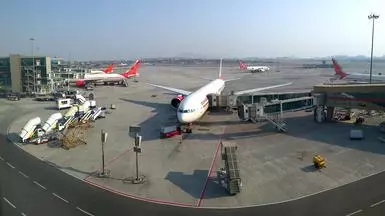In the age of flying cars, airports must adapt to new challenges. This means new designs, regulations, and infrastructure to handle the demands of air traffic in the future.
As new technologies emerge and the aviation industry evolves, airports must keep pace to deliver safe and efficient services for passengers and vehicles. This includes developing new landing and takeoff protocols, managing air traffic flows, and building facilities equipped with charging stations, repair services, and other amenities.
With the rise of electric and hybrid vehicles, airports must also explore new energy sources and storage solutions to power flying cars. As cities become more congested, flying cars could offer a viable solution to today’s transportation challenges, and airports will play a critical role in making this technology a reality.

Credit: www.nytimes.com
The Concept Of Flying Cars
Airports are constantly evolving, adapting their infrastructure to accommodate new modes of transportation. The advent of flying cars has generated significant excitement among the masses. While this concept is still in its infancy, there is a lot of promise for the future.
Let’s delve into the concept of flying cars and explore its history, development, and challenges to understand its potential impact on the airports of the future.
Defining Flying Cars
Flying cars, also referred to as roadable aircraft or flying vehicles, are a type of hybrid vehicle that can take off and land like an airplane and drive on ordinary roads like a car. In simple terms, they are a fusion of two modes of transportation- air and road.
Brief History Of Flying Cars And Its Development
The concept of a flying car dates back to the 1920s. Since then, there have been several attempts to create prototypes, but none have been successful. In recent years, advances in technology have brought the idea closer to reality. Several companies, including uber, boeing, and airbus, are working on developing prototypes.
However, the path to developing a commercial product is complicated, with several regulatory and technological hurdles to overcome.
Current Challenges With Flying Cars
Despite significant advancements, there are several challenges that need to be addressed before the concept of flying cars can become a reality. Some of the significant challenges include:
- Cost: Developing a flying car is a costly affair, and manufacturers need to ensure that the product is cost-effective for consumers.
- Regulations: There are several regulatory hurdles in place, with many countries currently lacking the necessary infrastructure to support flying cars.
- Infrastructure: Airports and roads will require significant upgrades to support the mass adoption of flying cars. It is unclear how this will be funded and implemented.
- Safety: Flying cars pose unique safety challenges that need to be addressed to ensure that they are safe for passengers and other road and air users.
While the concept of flying cars is intriguing, it still has a long way to go before it can become a reality. Overcoming the challenges outlined above will be critical to realizing the potential of this innovative mode of transportation.
As airports prepare their infrastructure for the future, it will be interesting to see how the concept of flying cars will shape the airports of tomorrow.
Impacts On The Airport Industry
Air travel is an exciting and rapidly-changing industry. With the advent of flying cars, airports are bound to go through significant transformations. So what kind of impact will flying cars have on the airport industry? Read on to find out more.
Increasing Number Of Flights In Busy Airspace
Flying cars will lead to an increase in air travel, resulting in a higher volume of flights competing for space in the air. This is likely to put air traffic control under immense pressure. Here are some key points to consider:
- With the rise of flying cars, the number of aircraft in the sky is likely to increase significantly.
- This increase will put additional pressure on air traffic control to manage the high volumes of air traffic.
- Airports will need to invest in new air traffic management systems to ensure the safe and efficient management of air traffic.
Navigational Technologies And Air Traffic Control Systems
With the influx of flying cars, airports and air traffic control systems must adapt. Here are a few points to consider when it comes to navigational technologies and air traffic control systems:
- Airports will have to adopt advanced navigation technologies to enable the safe operation of flights in crowded airspace.
- Air traffic control systems must provide real-time data, enabling air traffic controllers to manage the high volume of air traffic efficiently.
- Navigational technologies must be able to communicate with flying cars to ensure efficient and safe travel in the air.
Infrastructure And Design Needs Of Airports
Flying cars will also impact the infrastructure and design needs of airports. Here are some key points to consider:
- Airports will need new infrastructure and technologies to accommodate flying cars, such as vertical take-off and landing (vtol) capabilities and charging modules.
- Airport designers will have to ensure that airport terminals and buildings can accommodate flying cars.
- Airports may have to deploy automated vehicles or drones for ground operations, which will require separate infrastructure and design changes.
As flying cars become more commonplace, the airport industry will need to adapt its operations, technologies, and infrastructure to accommodate them. By investing in navigational technologies, air traffic control systems, and airport infrastructure and design changes, airports can facilitate the safe and efficient management of air traffic while providing a seamless travel experience for passengers.
Sustainable Aviation Fuels
Airports of the future: adapting to the age of flying cars
The future of aviation is limitless, and with the advent of flying cars, airports will have to change drastically. Sustainable aviation fuels (safs) are one such development that will play a crucial role in reducing the carbon footprint of air travel.
In this section, we’ll look at the advantages, challenges, and upcoming innovations in safs.
Advantages Of Sustainable Aviation Fuels
- Safs emit up to 80% fewer carbon emissions compared to traditional jet fuel.
- They can be created from renewable energy sources such as plant oils and waste materials, reducing dependence on non-renewable resources.
- Safs are less harmful to humans and the environment, reducing pollution and improving air quality.
- By using safs, airlines can showcase their commitment to environmental sustainability, attracting a new generation of environmentally conscious travelers.
Challenges To Implementing Sustainable Aviation Fuels
- Safs are still in the early stages of development and are not yet widely available.
- The cost of producing safs is still high, making it an impractical alternative for budget airlines.
- The logistics of producing, transporting, and storing safs need to be improved to keep up with the demand.
- There is a lack of infrastructure that can support the use of safs, making it challenging for airlines to scale up their usage.
Future Innovations In Sustainable Aviation Fuels
- Scientists are exploring the use of algae and municipal waste as potential sources for safs.
- The development of synthetic fuels that do not require biomass is underway, making it possible to produce safs that are cost-effective and can be produced at scale.
- Investments are being made to improve the infrastructure and technology for saf production, making it easier to distribute and use safs at airports.
- With the rise of electric planes, there are discussions about using safs as a source of electricity for these planes, making them even more sustainable.
As we can see, the advantages of safs are clear, but challenges remain in its implementation. With ongoing innovations and investment, the future of aviation may soon be more sustainable, thanks to initiatives like safs.
Frequently Asked Questions Of Airports Of The Future: Adapting To The Age Of Flying Cars
Will Airports Become Obsolete With The Arrival Of Flying Cars?
No, airports will not become obsolete. However, airports will need to adapt to the new technology of flying cars.
How Will Airports Manage Air Traffic With Flying Cars?
Airports will need to integrate air-traffic management systems to handle both traditional planes and flying cars.
What Infrastructure Changes Will Be Necessary For Airports?
Airports will require new infrastructure such as vertiports, charging stations, and new control towers to accommodate flying cars.
Conclusion
As flying cars inch closer to reality, airports face the daunting task of adapting to these new vehicles. From new infrastructure to air traffic management, airports of the future must find ways to modernize and prepare for the age of airborne cars.
Increased efficiency, reduced traffic congestion, and decreased travel times are just a few of the benefits that flying cars could bring to aviation and overall transportation. However, significant challenges remain to make this a reality. The success of this transition will depend on partnerships between infrastructure providers, aviation authorities, and automakers.
While it’s still too early to predict how airports will evolve, one thing is certain: flying cars are coming, and the aviation industry must be ready to accommodate them. The future of air travel may seem like a scene out of science fiction, but it’s becoming increasingly clear that the future is closer than we think.

